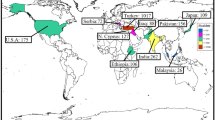Abstract
Improvements of the soils in sites are usually necessary to achieve the desired strength, compressibility and hydraulic conductivity of soils. Generally, improvement in compaction is preferred and applied in sites. The compaction curve and associated characteristics, namely maximum dry unit weight and optimum moisture content, should be determined in the laboratory by using Proctor test procedures. However, a number of Proctor tests need to be carried out for projects like earth dams, embankments and highways. In this paper, a simplified and dependable way of obtaining compaction characteristics and compaction curves at different compaction energy levels for preliminary designs is introduced. For this purpose, Proctor compaction tests were conducted with different soils and at different compaction energy levels apart from using extensive results found in the literature. It was found out that by only getting the compaction characteristics from plastic limit an approximate compaction curve can be obtained from family curves. The approximate compaction curve compares well with the tested values too. Maximum dry density predicted is 0.986 times the maximum dry density at plastic limit, whereas predicted optimum moisture content is 0.99 times the actual optimum moisture content.













Similar content being viewed by others
References
Benson CH, Trast JM (1995) Hydraulic conductivity of thirteen compacted clays’. Clays Clay Miner 43(6):669–681
Blotz RL, Benson CH, Boutwell P (1998) Estimating optimum water content and maximum dry unit weight for compacted clay. J Geotech Geoenviron Eng 124(9):907–912
Boynton SS, Daniel DE (1985) Hydraulic conductivity tests on compacted clay. J Geotech Eng 111(4):465–478
NG KS, Chew YM, Osman MH, Mohamad Ghazali SK (2015) Estimating maximum dry density and optimum moisture content of compacted soils. In: International conference on advances in civil and environmental engineering, Faculty of Civil Engineering, Universiti Teknologi MARA Pulau Pinang
Daniel DE (1984) Predicting hydraulic conductivity of clays. J Geotech Eng 110:285
Daniel D, Benson C (1990) Water content—density criteria for compacted soil liners. J Geotech Eng 116(12):1181–1190
Daniel D, Wu Y (1993) Compacted clay liners and covers for arid sites. J Geotech Eng Div 112(7):669–681
Day SR, Daniel DE (1985) Hydraulic conductivity prototype clay liners. ASCE J Geotech Eng 111:957–970
Elsbury BR, Daniel DE, Sraders GA, Anderson DC (1990) Lessons learned from compacted clay liner. J Geotech Eng 116(11):1641–1660
Farooq K, Khalid U, Mujtaba H (2015) Prediction of compaction characteristics of fine-grained soils using consistency limits. Arab J Sci Eng 41(4):1319–1328
Foreman DE, Daniel DE (1986) Permeation of compacted clay with organic chemicals. J Geotech Eng 112(7):669–681
Gurtug Y, Sridharan A (2002) Compaction characteristics of fine grained soils. Geotechnique 52(10):761–763
Hilf J (1956) Rapid method of construction control for embankments of cohesive soil, vol 26. Engrg. Monograph, U.S. Bureau of Reclamation, Dever, pp 1–29
HMSO (1957) Soil mechanics for road engineers. Her Majesty’s Stationery office, London
Horpibulsuk S, Rachan R, Kaktan W (2006) Prediction of compaction curves at various energies using one point method. In: International symposium on low land technology, Saga, Japan, pp 97–102
Johnson AW, Sallberg JR (1960) Factors that influence field compaction of soils: compaction characteristics of field equipment. Highway research board, Bulletin, vol 272. National Academy of Sciences, Washington
Johnson AW, Sallberg JR (1962) Factors influencing compaction test results. Highway research board, Bulletin, vol 319. National Academy of Sciences, National Research Council, Washington
Jumikis A (1958) Geology and soils of the Newark (N.J.) metropolitan area. J Soil Mech Found Div 84(2):1–41
Kolay E, Baser T (2014) Estimating of the dry unit weight of compacted soils using general linear model and multi-layer perceptron neural networks. Appl Soft Comput 18:223–231
Leroueil S, Bouchard R, Bourret M (1990) Influ conditions de mise en place sur la performance d’une md’argile. In: Proceedings, 43rd Canadian geotechnical conference, Quebec, vol 1, pp 367–375
Matteo LD, Bigotti F, Ricco R (2009) Best-fit models to estimate standard proctor properties of compacted soil. J Geotech Geoenviron Eng 135(7):992–996
McRae J (1958) L.Index of compaction characteristics. In: Symposium on application of soil testing in highway design and construction, ASTM, STP.239, pp 119–127
Mundell JA, Bailey B (1985) The design and testing of a compacted clay barrier layer to limit percolation through landfill covers. In: Johnson J et al. (eds) Hydraulic barriers in soil and rock, ASTM STP 874. ASTM, Philadelphia, pp 246–262
Noor SC (2011) Estimation of proctor of compacted fine grained soils fron index and physical properties. Int J Earth Sci Eng 4:147–150
Ring GW, Hallberg JR, Collins WH (1962) Correlation of compaction and classification test data. In: National Academy of Sciences-National Research Council, vol 325. Highway Research Board, NRC, Washington, pp 55–72
Sivrikaya O (2008) Models of compacted fine-grained soils used as mineral liner for solid waste. Environ Geol 53:1585–1595
Sivrikaya O, Togrol E, Kayadelen C (2008) Estimating compaction behavior of fine-grained soils based on compaction energy. Can Geotech J 45(6):877–887
Sivrikaya O, Kayadelen C, Çeçen E (2013) Prediction of the compaction parameters for coarse-grained soils with fines content by MLR and GEP. Acta Geotech Slov 2:29–41
Sridharan A, Nagaraj HB (2005) Plastic limit and compaction characteristics of fine grained soils. Ground Improv 9(1):17–22
Sridharan A, Rao SM, Sanjeev Joshi (1990) Classification of expansive soil by sediment volume method. Geotech Test J ASTM 13(4):375–380
Stewart JP, Nolan TW (1987) Infiltration test of hydraulic conductivity of soil liners. Geotech Test J 10(2):41–50
Wang M, Huang C (1984) Soil compaction and permeability prediction models. J Geotech Geoenviron Eng ASCE 110:1063–1083
Wesley LD (1973) Some basic engineering properties of halloysite and allophane clays in Java. Geotechnique 23(4):471–494
Author information
Authors and Affiliations
Corresponding author
Rights and permissions
About this article
Cite this article
Gurtug, Y., Sridharan, A. & İkizler, S.B. Simplified Method to Predict Compaction Curves and Characteristics of Soils. Iran J Sci Technol Trans Civ Eng 42, 207–216 (2018). https://doi.org/10.1007/s40996-018-0098-z
Received:
Accepted:
Published:
Issue Date:
DOI: https://doi.org/10.1007/s40996-018-0098-z




